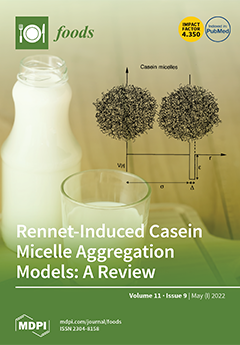Double emulsions are a type of multiple emulsions, which can be defined as a multicompartmentalized system where the droplets are dispersed into the continuous phase containing other emulsions. Although double food-grade emulsions have been manufactured, there is a lack of scientific background related
[...] Read more.
Double emulsions are a type of multiple emulsions, which can be defined as a multicompartmentalized system where the droplets are dispersed into the continuous phase containing other emulsions. Although double food-grade emulsions have been manufactured, there is a lack of scientific background related to the influence of different processing conditions. This work analyses the influence of processing variables in (W
1/O/W
2) double emulsions: passes through the valve homogenizer, pressure applied, lipophilic emulsifier concentration, the ratio between the continuous phase (W
2) and the primary emulsion (W
1/O), and the incorporation of xanthan gum (XG) as a stabilizer. The results obtained show that these emulsions can be obtained after selecting suitable processing conditions, making them easily scalable in industrial processes. In terms of droplet size distribution, the input of higher energy to the system (20 MPa) during emulsification processing led to emulsions with smaller droplet sizes (D
3,2). However, more monodispersed emulsions were achieved when the lowest pressure (5 MPa) was used. As for the number of passes, the optimal (emulsions more monodispersed and smaller droplet sizes) was found around 2–3 passes, regardless of the valve homogenizer pressure. However, emulsions processed at 20 MPa involved lower encapsulation efficiency (E
E) than emulsions processed at 5 MPa (87.3 ± 2.3 vs. 96.1 ± 1.8, respectively). The addition of XG led to more structured emulsions, and consequently, their kinetic stability increased. The results obtained indicated that a correct formulation of these W
1/O/W
2 double emulsions allowed the optimal encapsulation of both hydrophilic and lipophilic bioactive compounds. Thus, the development of food matrices, in the form of multiple emulsions, would allow the encapsulation of bioactive compounds, which would result in the development of novelty food products.
Full article






